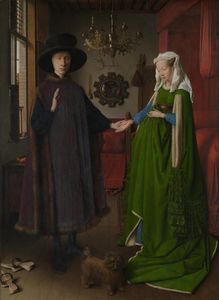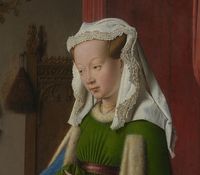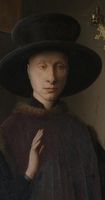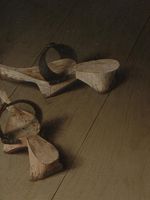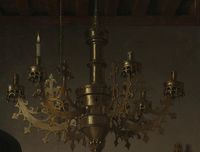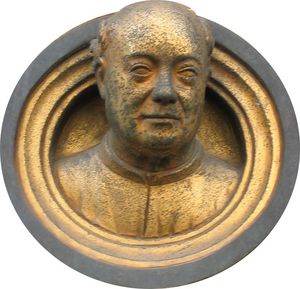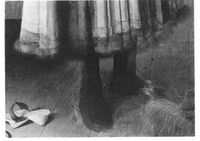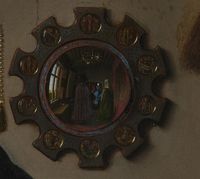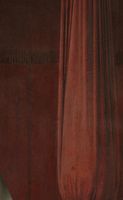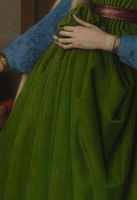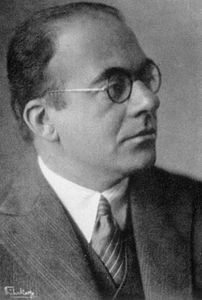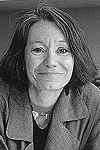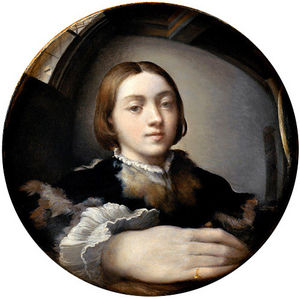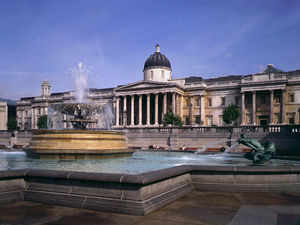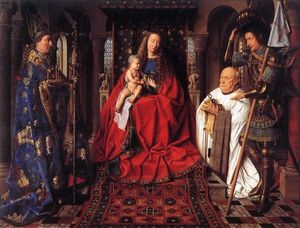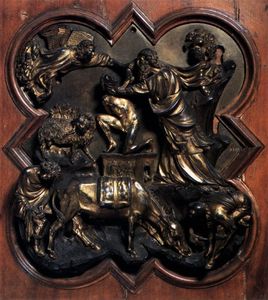The Arnolfini Portrait
- Date of Creation:
- 1434
- Alternative Names:
- The Arnolfini Wedding, The Arnolfini Marriage, The Arnolfini Double Portrait
- Height (cm):
- 818.00
- Length (cm):
- 597.00
- Medium:
- Oil
- Support:
- Wood
- Subject:
- Figure
- Technique:
- wet-in-wet
- Characteristics:
- Perspective, Portrait
- Framed:
- No
- Web Page:
- http://www.nationalgallery.org.uk/paintings/jan-van-eyck-the-arnolfini-portrait
- Art Movement:
- Renaissance
- Created by:
- Current Location:
- London, United Kingdom
- Displayed at:
- National Gallery London
- Owner:
- National Gallery London
- The Arnolfini Portrait Page's Content
- Story / Theme
- Inspirations for the Work
- Analysis
- Critical Reception
- Related Paintings
- Locations Through Time - Notable Sales
- Artist
- Art Period
- Bibliography
The Arnolfini Portrait Story / Theme
The Arnolfini Portrait was originally believed to be a portrait of Giovanni di Arrigo Arnolfini and his wife Giovannna Cenami, but it is now thought that the couple married 13 years after the painting was painted.
The painting depicts a rich couple, both from the largest banking families in Lucca, convening in a parlor of French fashion. The couple is warmly and finely dressed, their garments are cut with fur, even though the fruit outside the windows on the tress suggest that it is summer time.
While the pair are expensively dressed, they do show some restraint. Besides the woman's plain necklace and rings, she does not wear an abundance of jewelry which would have been reserved for the aristocrats.
The painting probably resembles a wedding or an agreement of marriage of some sort. It is important to note that this painting would have been proof of the agreement and would have been legally binding. Jan van Eyck had just acquired property in the area and could have been fully recognized as a notary.
There are many different interpretations of the painting;
• A memorial for a dead wife
• A gift for the Arnolfini that had the purpose of showing their wealth
• That the painting shows a betrothal and not a marriage
• Grant of legal authority from husband to wife to conduct business in his name
• To show Giovanni's good character, possibly to promote business relations
• The signature on the back wall is a legal document of a marriage
• That none of the symbols have any deeper meaning
• It is only a double portrait and nothing else
Gender roles:
The position of the characters suggests a portrayal of gender roles as the women stands next to the bed as the caretaker and her husband stands next to the window as his work is outside of the home.
She looks at him squarely and not at the floor showing that she is his equal. His hand is raised, showing power while she has her hand lowered or possibly his raised hand is a sign of oath taking in their marriage.
Joined hands:
The holding of hands is thought to represent a marriage contract. It has also been argued that the joined hands mean equal hands in business deals, and he is giving her the power to act in business.
Pregnant:
Although the woman looks to be pregnant, it is thought that it was simply the fashion at the time. The more clothing a person wore the richer they were. Also of the possible women the painting could portray, all died childless.
Headdress:
Non-married women would wear their hair down. This woman wears hers up indicating that she is probably married.
Clogs:
There is a pair of clogs thrown aside. After marriage husbands usually presented their wives with clogs.
Dog:
The lap dog could be seen as the couple's desire to have a child or as a symbol of fidelity, or simply marking their status as a dog signifies wealth.
Candle:
There are two candles, one lit and one burnt out. Possibly the candle represents the death of the wife. The candle could also be the candle used in Flemish marriage customs.
Saint Margaret:
There is a carved statue of Saint Margaret on the bedpost. Saint Margaret is the patron saint of pregnancy and childbirth.
Mirror:
The mirror gives the viewer the most encompassing visual perspective in the paintings. In the mirror are two figures in the doorway possibly to represent witnesses for the marriage to make it legal. Note, we also have van Eyck's signature here which could act of that of a notary's.
Around the mirror small scenes of Jesus' passion are shown. On the wife's side of mirror, only pictures of his death and resurrection are shown while on the husband's only those of Christ's life.
The Arnolfini Portrait Inspirations for the Work
Painted for and of the Lucchese merchant, Giovanni supplied silk and velvet to Philip the Good under whom Jan was working.
The painting, among the other things argued, highlights the merchant's wealth. Jan was probably commissioned by the merchant through the Duke. It is also possible that the painting could have been commissioned by Signor Cenami, father of the bride, to have proof.
Also the portrayal of the couple looks remarkably similar to King Solomon and the Queen of Sheba in Lorenzo Ghibteri's Gates of Paradise.
The Arnolfini Portrait Analysis
Probably van Eyck's most discussed work, the Arnolfini Portrait is rich in iconography and gives the viewer an insight into Flemish culture.
Composition:
Under recent technological developments, it has been found that Jan van Eyck used under drawings to plan out the painting. We can see variations and changes he made to this piece while drawing and painting.
The position of Giovanni's feet was changed. Van Eyck seems to have preferred a more closed stance for him than the original drawing.
Color palette:
Here the use of bright colors works to highlight the wealth of the two figures. Their drapery is brightly colored and their guest room is displayed in rich tones.
The color green in Italy was reserved for those involved in banking. Depicting the woman in green had to represent that she was from the high business or merchant class.
Use of light:
In this painting van Eyck uses both direct and indirect light. The light from the window provides the direct light into the scene which can be seen on the shading of the oranges and the reflection on the chandelier and other surfaces.
The achievement of light rendered in this painting, again, is largely due to the minimalistic use of oil and degree of shading obtained by layering the paint.
Technical innovations:
The artist is credited with achieving innovations in minimalism and his attention to detail is uncanny. The mirror in the back of the painting is unique in that the whole scene is replicated in the small mirror. It is thought that van Eyck used a magnifying glass.
Use of technique:
As seen in the shading of the images, van Eyck took advantage of the drying time, much longer than that of tempera or fresco, and blended the colors with the appropriate shading, a technique called wet-in-wet. Layering the paint allowed the artist to blend the colors and eliminate their borders.
Perspective:
It has been suggested that van Eyck used atmospheric pressure and pagan astronomy to develop the sophisticated possible vanishing-points - in the mirror, or perhaps the larger oval-shaped vanishing-point taking place in the center of the painting.
Mood, tone and emotion:
The light coming from the window on the left sweeps a pleasing glow over the bedroom. The scene is crowded by different images and symbols which all seem to be standing still.
The portrait of Giovanni is one of confidence and with his left hand almost in the position of a saint's. The bride or woman has a calmness to her and the overall scene suggests a wedding or a contract.
Brush stroke:
Van Eyck's brush strokes are almost impossible to see in his small and medium-sized work. It has been argued that perhaps his paintbrushes consisted only of one hair.
Textures:
Van Eyck used multiple layers of thin glaze to obtain his deep, rich colors. Working with oils. he had to layer the paint on top of itself many times until he reached the tone he preferred, hence the painting is thicker where dark colors are present and thinner in lighter areas.
This technique was also crucial in his development of the textures, like the design of the woman's robe and the lace around the dress.
The Arnolfini Portrait Critical Reception
During life:
After the Arnolfini Portrait was completed it is unknown who held onto it before it made a European tour but it has been documented in Austria, Spain and in England, where it remains.
After death:
For years the themes presented in the painting have remained a mystery.
"Few of us would disagree with the notion that viewers bring expectations of their own to an understanding of a work of art; few of us are likely to agree, however, about how little or how much autonomy a viewer enjoys in arriving at his or her own interpretation. For many, the range and nature of constraints on a given viewer's response are controversial matters. On one side are scholars, in the tradition of Panofsky, who limit the "beholder's share" by excluding from the interpretive process issues of daily life that inevitably attend it. Such individuals prefer to position art --its invention and appreciation-- above ordinary day-to-day encounters and to identify its sources and its purposes with what may be seen as privileged rather than prosaic claims. Audiences do not really matter much at all from this perspective. Other scholars, however, would argue that all meaning is lodged in a viewer's experience --though language-driven-- is not exclusively text-based, and that politics and sex have as much claim as religious or literary tracts in any interpretive strategy. Many scholars stand, knowingly or not, somewhere in between. "
Linda Seidel in her Jan Van Eyck's Arnolfini Portrait: Stories of an Icon (Cambridge University Press, 1993, p. 129)
The Arnolfini Portrait Related Paintings
The Arnolfini Portrait Locations Through Time - Notable Sales
Between 1434-1516 the Arnolfini Portrait was in the possession of Don Diego de Guevara, a Spanish career courtier of the Habsburgs. In 1516 he gave the portrait to Margaret of Austria, Habsburg Regent of the Netherlands. The painting was listen in 1524 in a Mechelen inventory belonging to Arnoult Fin.
In 1530 Mary of Hungary inherited the painting and upon her death in 1558 it was inherited by Philip II of Spain.
In 1599 the painting was seen in the Alcazar palace in Madrid with the inscription, "See that you promise: what harm is there in promises? In promises anyone can be rich," by Ovid painted on the frame.
By 1794 the work was being housed in the Palacio Nuevo in Madrid. In 1816 the painting became the possession of Colonel James Hay, a Scottish soldier who claimed that he fell in love with it while recovering from an injury during the Battle of Waterloo in Brussels.
However, it's more likely that during Hay's expedition in Spain British troops ransacked a couch filled with art work stolen by Joseph Bonaparte. Hay offered the painting to George IV of England, then Prince Regent, and the Prince had it on display at the Carlton House.
In 1818 the Prince returned the painting to Hay and it was featured in an exhibition in 1841. A year later it was purchased by the National Gallery, London for 600 pounds.
The Arnolfini Portrait Artist
Born sometime around 1385 Jan van Eyck most likely studied under his brother, Herbert van Eyck. Jan worked under Philip the Good, Duke of Burgundy, and is responsible for the Ghent Altarpiece and the Arnolfini Portrait, two of the most famous paintings of the early Northern Renaissance.
On his voyages for the Duke, van Eyck served as a painter, traveler and diplomat. Probably traveling to Italy, Spain, Portugal and the Holy Lands, it is thought that the artist picked up different styles and inspiration but it is the minimalist style tha he is famous for and this came to define the Northern Renaissance.
Although Jan van Eyck worked under the Duke he still accepted commissions from various autocrats and was one of the first to produce portraits. He developed the 3/4 profile view in the portrait, a technique which is still used today.
The Arnolfini Portrait Art Period
For almost a thousand years Europe lay in the dark ages under a feudal society without any significant advancement. Sometime in the 14th Century Europe serfs were living as free men, the printing press was invented, commerce was taking off and new ideas arose.
With mobility, the rise of the merchant class led to an increase in ideas, philosophy, artistic advancements and scientific innovations.
North and South:
Old religious ideas were beginning to change again, especially in the north which would be home to the Reformation.
In Italy the Renaissance in architecture and sculpture had already taken off with the innovations made by Donatello and Brunelleschi. Insights in perspective and mathematics taken from the classics were being to show humanity in a new light.
The Renaissance would take hold across both sides of Europe, although fundamentally in different manners. Later, ideas from the north and south would mix and spur along further advancement.
The Arnolfini Portrait Bibliography
To find out more about the life and works of Jan van Eyck please refer to the following recommended sources.
• Borchert, Till-Holger. Jan van Eyck. Taschen Deutschland Gmbh, 2008
• Borchert, Till-Holger. Renaissance Realist (Taschen Basic Art Series). Taschen GmbH, 2008
• Graham, Jenny. Inventing Van Eyck: The Remaking of an Artist for the Modern Age. Berg Publishers 2007
• Harbison, Craig. Jan Van Eyck: The Play of Realism. Reaktion Books, 2011
• Nash, Susie. Northern Renaissance Art (Oxford History of Art). OUP Oxford, 2008
• Seidel, Linda. Jan Van Eyck's Arnolfini Portrait: Stories of an Icon. Cambridge University Press, 1993

